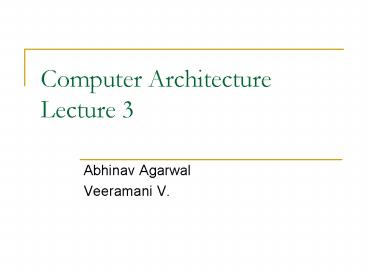Computer Architecture Lecture 3 - PowerPoint PPT Presentation
Title:
Computer Architecture Lecture 3
Description:
source: http://cse.stanford.edu/class/sophomore-college/projects-00/risc ... Instructions should be commited in-order. Memory instructions? Is dependency clear? ... – PowerPoint PPT presentation
Number of Views:40
Avg rating:3.0/5.0
Title: Computer Architecture Lecture 3
1
Computer ArchitectureLecture 3
- Abhinav Agarwal
- Veeramani V.
2
Quick recap Pipelining
source http//cse.stanford.edu/class/sophomore-co
llege/projects-00/risc/pipelining/
3
Quick recap Problems
- Data hazards
- Dependent Instructions
- add r1, r2, r3
- store r1, 0(r4)
- Control Hazards
- Branches resolution
- bnz r1, label
- add r1, r2, r3
- label sub r1, r2, r3
- Structural Hazards
4
Data Hazards
- RAW hazard Read after Write
- add r1, r2, r3
- store r1, 0(r4)
- WAW hazard Write after Write
- div r1, r3, r4
- add r1, r10, r5
- WAR hazard Write after Read
- Generally not relevant in simple pipelines
5
Remedies
- Bypass values (Data forwarding)
- RAW hazards are tackled this way
- Not all RAW hazards can be solved by forwarding.
E.g. Load delay, What about divide? - What is the solution?
- Static compiler techniques
6
Can we do better?
- Execute independent executions out-of-order? What
do we require for this? - lw r4, 0(r6) Cache miss - Takes time
- addi r5, r4, 0x20
- and r10, r5, r19
- xor r26, r2, r7
- sub r20, r26, r2
- Fetch more instructions...
- Instructions should be commited in-order
- Memory instructions? Is dependency clear?
7
The WAW hazard
- Is it unavoidable? What is the reason for such
hazard? - Register renaming
- More physical registers
- Logical registers mapped to physical registers
available when the instruction is decoded
8
Control Hazard
- Branch delay slot
- bnz r1, label
- add r1, r2, r3
- label sub r1, r2, r3
- Save one cycle stall. Fetch in the negative edge
to save another. - Deeper pipelines.
- Such static compiler techniques would not work.
9
What can be done?
- Predict if the branch will be taken or not
- History of each branch saved and prediction done
accordingly. - Example Bimodal predictor
- Branch prediction is very important and complex
these days due to some architectural innovations
and some bottlenecks.
10
Bimodal predictor
- Entry 2-bit saturating counters
- Index least significant bits of the instruction
address - Prediction Combinatorial
- Update When branch is resolved
11
Remedies to Structural hazards
- Simplest solution Increase resources, functional
units (Silicon allows us to do this) - Another solution Pipeline the functional units
- Pipelining is not always possible/feasible.
12
Superscalar execution!
- Execute more than one instruction every cycle.
- Make better use of the functional units
- Fetch, commit more instructions every cycle.
13
Memory Organization in processors
- Caches inside the chip
- Faster Closer
- SRAM cells
- They contain recently-used data
- They contain data in blocks
14
Rational behind caches
- Principle of spatial locality
- Principle of temporal locality
- Replacement policy (LRU, LFU, etc.)
- Principle of inclusivity
15
References
- http//en.wikipedia.org/wiki/Hazard_(computer_arch
itecture) - http//www.csee.umbc.edu/plusquel/611/slides/chap
3_3.html































